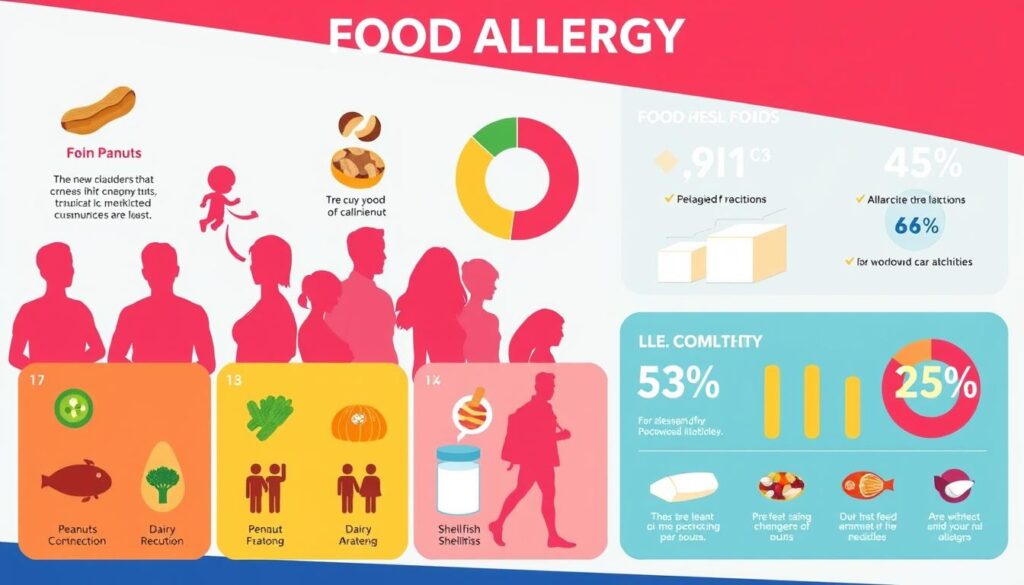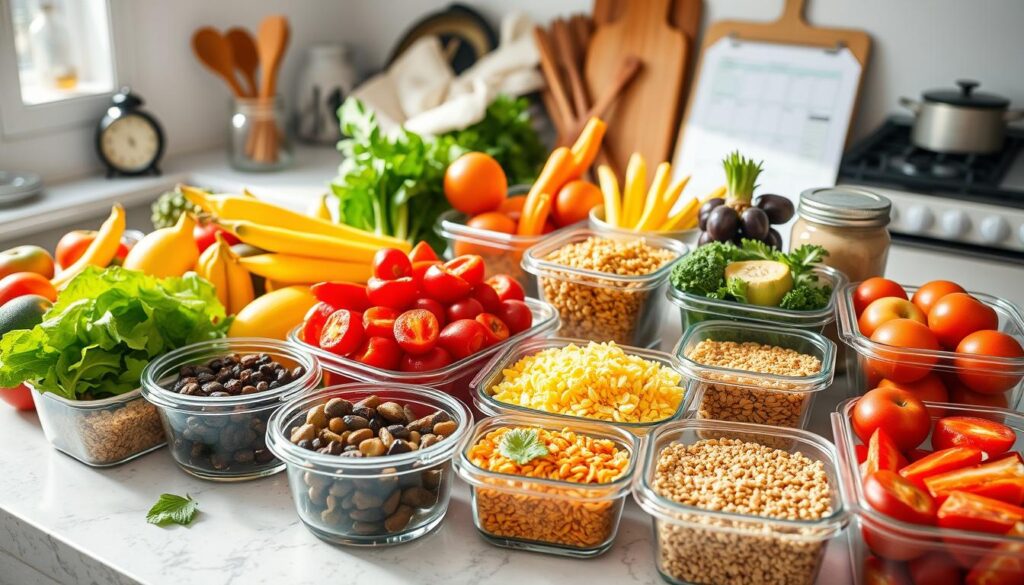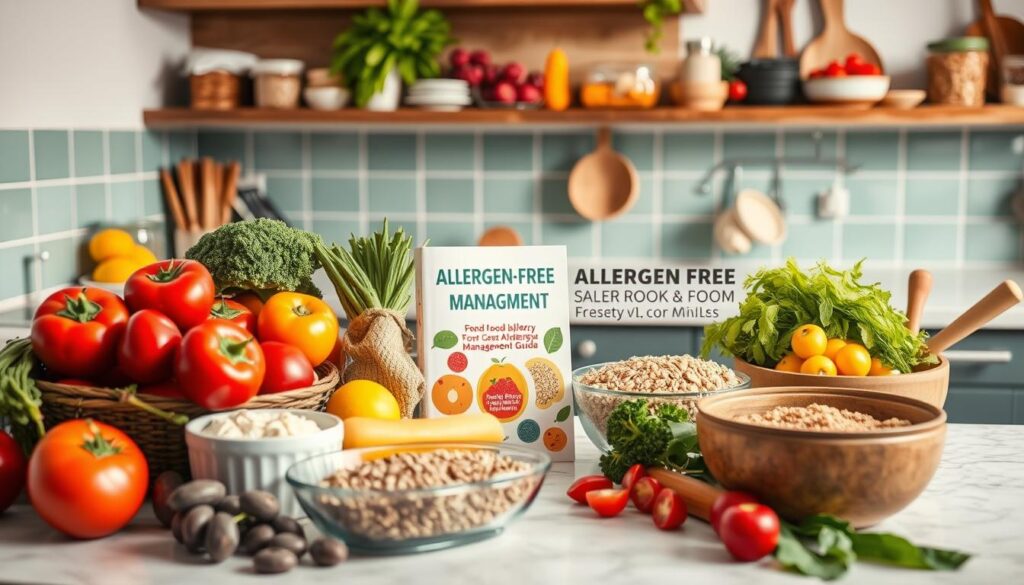Dealing with food allergies can seem overwhelming, and you’re not alone. This guide will teach you how to manage your allergies well. Are you aware of the hidden triggers lurking in your everyday meals? Get ready to learn how to eat safely at home or out with friends and manage food allergy testing.
Table of Contents
ToggleKey Takeaways
- Identify common food allergens and understand their effects on your body
- Learn to navigate food labels and spot hidden ingredients that may trigger reactions
- Develop effective strategies (including food allergy testing) to prevent cross-contamination and maintain a safe kitchen
- Prepare for emergencies by recognizing anaphylaxis symptoms and mastering auto-injector use
- Discover tips for dining out and traveling with confidence, empowering you to live life to the fullest
Understanding Food Allergies: Essential Basics for Safety
Food allergies can be scary and confusing. But knowing the basics helps keep you safe. We’ll look at common allergens, their effects, and the difference between allergies and intolerances. This info helps you make smart choices and handle your food allergy with confidence.
Common Food Allergens and Their Effects
The top food allergens are peanuts, tree nuts, milk, eggs, soy, wheat, and shellfish. These foods can cause mild skin issues or serious anaphylaxis. Knowing how each allergen affects you is key for safe food choices.
| Allergen | Potential Symptoms |
|---|---|
| Peanuts | Hives, swelling, difficulty breathing, digestive issues |
| Tree Nuts | Rash, throat tightness, nausea, dizziness |
| Milk | Bloating, diarrhea, vomiting, respiratory problems |
| Eggs | Skin rashes, gastrointestinal distress, anaphylaxis |
Difference Between Food Allergies and Intolerances
It’s vital to know the difference between food allergies and intolerances. Allergies are immune system reactions that can be severe. Intolerances are digestive problems that cause discomfort but aren’t life-threatening. Getting food allergy testing done is important to find the right treatment.
Risk Factors and Prevalence for Food Allergies
Food allergies can happen to anyone, but some groups are at higher risk. These include people with a family history of allergies, asthma, or early exposure to allergens. The CDC says about 32 million Americans have food allergies, with peanut and tree nut allergies being the most common. Knowing the risks helps us stay safe and healthy.

“Food allergies are a growing public health concern, with increasing prevalence and significant impact on individuals and their families.
Food Allergy Testing & Management: Creating Your Action Plan
Managing food allergies can seem daunting, but a good plan can help you stay safe. Let’s explore the key steps to make your own food allergy testing & management plan.
Prioritize Diet Planning
Your plan starts with diet planning. Work with your doctor to find out what foods you’re allergic to. Then, create a meal plan that’s healthy and avoids those foods. A balanced diet is important for your health.
Prepare for Emergencies
It’s important to think about emergencies, even if you don’t like it. Emergency preparedness is a big part of your plan and it begins with food allergy testing. Make sure you have your epinephrine auto-injectors ready and know how to use them. Also, keep a list of emergency contacts and consider taking a first-aid course.
Develop Daily Management Techniques
It’s important to make managing food allergies a part of your daily life. Start by reading food labels carefully, carrying safe snacks, and telling others about your allergies. These habits can help keep you safe and healthy.
With a personalized plan, you can handle food allergies with confidence. Remember, your health and safety are the most important things. Taking action now will help you live your best life.

Smart Label Reading: Your First Line of Defense
Label reading is key when dealing with food allergies. It helps you spot hidden dangers and choose safe foods. Here are the essential skills you need to stay safe.
Hidden Ingredient Names to Watch For
Food allergies can be tricky because of their names. Look beyond “peanut” or “milk” for these sneaky names:
- Peanuts: Arachis oil, peanut flour, peanut protein, or hydrolyzed peanut protein
- Tree nuts: Almonds, cashews, hazelnuts, pecans, walnuts, and their oils
- Dairy: Casein, whey, lactose, or anything containing the word “milk”
- Eggs: Albumin, globulin, or lecithin
- Wheat: Gluten, flour, or anything containing the word “wheat”
Understanding Allergen Advisory Statements
Don’t just look at the ingredients. Watch for “may contain” or “processed in a facility that also processes.” These warnings are about cross-contamination risks.
Using Food Scan Genius App for Quick Checks
Make label reading easy with the Food Scan Genius app. It scans barcodes and shows allergen info. This app helps you choose safe foods quickly and confidently.
Label reading is the first and most important step in managing food allergies. With a little practice, it becomes second nature – and the Food Scan Genius app makes it even easier.
Cross-Contamination Prevention Strategies
Working in the kitchen with food allergies is a careful dance. But, with the right steps, we can lower cross-contamination risks. This makes cooking safer and free from allergens. Let’s look at how to keep allergens away with proper storage and cleaning.
Dedicated Prep Surfaces
Use special cutting boards, utensils, and areas only for safe food prep. This stops cross-contamination. It makes sure your safe dishes stay safe.
Thorough Cleaning Routines
Cleaning well is crucial to remove allergens. Clean all surfaces, tools, and pots before and after use. Focus on busy spots and hard-to-reach places where allergens might hide.
Ingredient Segregation
- Keep foods with allergens away from safe foods to avoid mistakes.
- Make sure to label containers so everyone knows what’s inside.
- Always check labels for hidden allergens in pre-made foods.
By using these cross-contamination prevention methods, we can make cooking safe and allergen-free. Enjoying meals without worry is possible. Small actions can greatly protect our health and safety.
Emergency Preparedness and Response Protocol
Being ready for emergencies is key when dealing with food allergies. We hope allergic reactions never happen, but knowing how to act is crucial. Learning how to use auto-injectors and making an emergency plan can help you stay safe.
Recognizing Anaphylaxis Symptoms
Anaphylaxis is a serious allergic reaction that needs quick medical help. Knowing the signs is the first step in handling an emergency. Look out for:
- Difficulty breathing or swallowing
- Rapid or weak pulse
- Dizziness or fainting
- Skin rashes, hives, or severe itching
- Nausea, vomiting, or diarrhea
Using Auto-Injectors Properly
If anaphylaxis happens, giving epinephrine right away is vital. Auto-injectors like EpiPen or Auvi-Q give the right amount of epinephrine. Make sure you know how to use them and always have them ready.
Emergency Contact Plan Development
Having a good emergency plan is important. Make a list of contacts, including your doctor and emergency services. Make sure your support team knows the signs of anaphylaxis and how to use epinephrine.
Being proactive and prepared can give you peace of mind. Remember, emergency preparedness is essential for managing your food allergy safely.
Safe Food Preparation and Kitchen Organization
Creating an allergen-safe kitchen is key for managing food allergies. Let’s look at tips to make your cooking space a allergen-free cooking and cross-contamination prevention haven.
Start by setting aside areas for allergen-free ingredients. Use separate utensils, cutting boards, and containers for these items. This helps prevent cross-contamination. Also, clean and sanitize all surfaces to remove allergen traces.
- Use color-coded or labeled containers to keep allergen-free foods separate.
- Store allergen-free items on top shelves, away from contaminants.
- Get a food processor or blender just for allergen-free recipes.
When cooking, be very careful with prep. Wash hands, surfaces, and equipment before and after touching allergens. Prepare allergen-free dishes first, then those with allergens.
Staying organized and vigilant in the kitchen is the key to ensuring a safe and enjoyable cooking experience for those with food allergies.
By following these steps, you can make your kitchen safe for allergen-free cooking. A bit of planning and care can reduce cross-contamination risks. This makes meal prep easier and less stressful.
Dining Out Safely with Food Allergies
Going out to eat shouldn’t stress you if you have food allergies. With the right tools and strategies, you can enjoy every meal. Let’s look at how to safely eat out and enjoy your food.
Restaurant Communication Tips
Talking clearly is crucial when you have food allergies. Tell the host or server about your dietary needs and allergies when you arrive. Be kind but firm, and ask questions if you’re unsure about anything.
Questions to Ask Food Service Staff
- What ingredients are used in this dish?
- Is the meal prepared in a dedicated allergen-free area of the kitchen?
- Can you confirm that this dish does not contain any of my allergens?
- Is it possible to have the meal prepared without the allergen-containing ingredients?
Using Food Scan Genius for Menu Verification
The Food Scan Genius app is a big help when you have food allergies. Scan the menu before you order to check for allergens. This quick check lets you enjoy your meal without worry.
| Feature | Description |
|---|---|
| Allergen Scanning | Quickly scan menu items to identify potential allergens. |
| Ingredient Breakdown | View a detailed breakdown of the ingredients in each dish. |
| Restaurant Ratings | See how allergy-friendly a restaurant is based on user reviews. |
With these tips and the Food Scan Genius app, dining out is safe and fun. Enjoy your meals and stay safe from allergens. Bon appétit!
Traveling with Food Allergies: Essential Tips
Starting a new adventure is exciting, but it’s even more important for those with food allergies. We’ve got you covered with key tips to stay safe and enjoy your travels.
Pack Your Emergency Kit
Make sure your emergency kit is ready before you leave. Include your auto-injectors, antihistamines, and any other necessary medication. Also, pack a food allergy ID card in the local language(s).
Communicate Your Needs
When booking places to stay and eat, tell them about your food allergies. Research allergen avoidance resources in the area. Carry a translation card to explain your needs easily.
Navigate Dining with Ease
Eating out can be tricky, but you can still enjoy your meals. Use allergen-friendly dining apps to check menu items. Always ask about food preparation and ingredients.
| Tip | Description |
|---|---|
| Pack Snacks | Bring your own non-perishable, allergy-friendly snacks to have on hand in case safe options are limited. |
| Check Airline Policies | Research your airline’s food allergy policies and protocols to ensure a smooth and safe flight experience. |
| Locate Nearest Hospitals | Research the locations of nearby hospitals and emergency medical facilities in case of an allergic reaction. |
With these tips, you can travel with confidence. Embrace new experiences while keeping your food allergies under control. Bon voyage, and may your travels be as safe as they are inspiring!
Building a Support System: Family and Community
Having a strong support system is key when managing food allergies. Teach your family and caregivers about food allergy management. This way, they know how to act in an emergency. Also, work with schools and other places to make sure they’re safe for you or your loved one.
Educating Family Members and Caregivers
Get your family and friends involved in your food allergy testing & journey. Teach them about the allergens to avoid and how to spot an allergic reaction. Show them how to use an epinephrine auto-injector. This will help you feel more at ease every day.
Working with Schools and Institutions
Team up with your child’s school or daycare to manage food allergies. Make sure they have the right plans and training in place. This way, your child can stay safe and healthy while they learn.
FAQ
What are the common food allergens and their effects?
Common food allergens include peanuts, tree nuts, milk, eggs, wheat, soy, fish, and shellfish. These can cause symptoms from mild skin issues to severe anaphylaxis. Knowing your specific triggers is key to managing their effects.
What’s the difference between food allergies and intolerances?
Food allergies are an immune system reaction to certain foods. Food intolerances, on the other hand, are digestive problems not involving the immune system. Allergies can be more dangerous, while intolerances are usually less severe but still uncomfortable.
What are the risk factors and prevalence of food allergies?
Food allergies can happen at any age but are more common in kids. Family history, age, and certain health conditions can raise your risk. About 32 million Americans have food allergies, with numbers increasing.
How do I create a comprehensive food allergy action plan?
To make a good food allergy plan, first identify your triggers. Then, plan a balanced diet and prepare for emergencies. We’ll help you create a plan that fits your needs.
What hidden ingredient names should I watch for when reading food labels?
Look out for names like casein (from milk), lecithin (from soy), and natural flavors. These can hide common allergens. Knowing these names helps you avoid hidden allergens.
How can I prevent cross-contamination in my kitchen?
To avoid cross-contamination, use separate areas for allergen-free foods. Clean surfaces and utensils well, store food properly, and plan meals carefully. These steps help keep your kitchen safe.
How can I recognize the symptoms of anaphylaxis and use an epinephrine auto-injector correctly?
Anaphylaxis is a severe allergic reaction needing quick treatment with epinephrine. Symptoms include trouble breathing, swelling, and a weak, fast pulse. Knowing how to use an auto-injector is crucial for emergency situations.
How can I communicate effectively with restaurant staff to ensure my food is safe?
When eating out, tell the staff about your food allergies. Ask about ingredients, how food is prepared, and cross-contamination risks. Tools like the Food Scan Genius app can also help check menu items.
What should I consider when traveling with food allergies?
Traveling with food allergies means being well-prepared. Bring essential medications, pack safe snacks, research dining options, and inform airlines, hotels, and restaurants. A good plan helps you enjoy your trips safely.
How can I educate my family and community about my food allergies?
It’s important to involve your family, caregivers, and local places in managing your food allergies. Teach them about your triggers, symptoms, and emergency steps. A supportive network ensures your needs are met everywhere.
Related Posts
- Eco-tip: Smart use of food can produce delicious meals – Ventura County Star
- Reading Food Packaging for Allergens Made Easy – Food Scan Genius
- How To Scan Food Labels for Allergens: 2025 Food Safety & Allergy Tips





